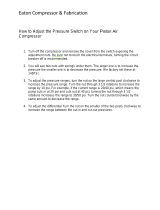
9013DB0701 Preventive Maintenance and Troubleshooting Guidelines for Class 9013F and 9013G Pressure Switches
12/2007 Frequently Asked Questions
© 2007 Schneider Electric All Rights Reserved
7
Frequently Asked Questions
Table 3: Frequently Asked Questions about Square D Class 9013F and 9013G Pressure Switches
Questions Answers
Can I use a 9013F water pump switch on an air compressor—or a
9013FHG air compressor switch on a water system?
Yes, but not you cannot use a 9013FSG water pump switch on a compressor requiring
Form X.
Is Form M4 (low pressure cut-out) available on the 9013GSG•••
pressure switches?
No, it is not available on the 9013GSG••• pressure switches. It is only available on the
9013FSG••• and the 9013FYG••• pressure switches.
Where can we find information about the 9213 pressure switch?
The information can be found in the 1947 Digest under Pressure Switches. For
information, contact Product Support.
Are 9013FRG pressure switches available in NEMA 3R? No, reverse action 9013F pressure switches are available only in NEMA 1 enclosures.
Are 9013 pressure switches DC voltage rated? Yes, the 9013 pressure switches are rated for DC as noted in Digest 174.
Do the 9013F and 9013G pressure switches accept both solid and
stranded wire?
Yes, the 9013F and 9013G pressure switches accept both solid and stranded wire.
Are the 9013FSG pressure switches CSA approved? Yes, these switches are CSA Approved, File #LR25490.
How can I connect a 9013G pressure switch to control a 3-phase
motor with only a 2-pole set of contacts?
Wire two legs of the 3-phase motor through the two poles of the pressure switch.
Breaking two phases will start and stop the motor. Wire the third leg direct. Install a
disconnect upstream of the pressure switch.
How do I select an appropriate pressure switch?
Refer to the catalog Commercial Pressure Switches Types F and G Class 9013
(9013CT9701) or Industrial Pressure Switches (9012CT9701) located in the Technical
Library at www.us.SquareD.com.
Will a 9013G pressure switch handle 20 A at 230 V, 1-phase and
3 hp?
The 9013G pressure switches are not current rated devices. They are hp rated devices
only. To use on 3-phase circuits, wire 2 phases through the 2 poles of the switch and
direct wire the third phase to one of the motor leads. This makes the lead live when the
pressure switch is off.
Can a 9013FSG2J20 pressure switch be installed horizontally, rather
than the standard vertical mounting?
Yes. The 9013FSG2J20 pressure switch can be mounted horizontally and still work
properly.
Is the catalog number for the 9013 pressure switch valid without the
pressure code?
No. You must have the J code pressure setting to order this product. If a list of pressure
settings is not available, use J99 and include the setpoints desired. The setpoints must
fall within the range of the pressure switch selected.
Is 9013FSG120J20 a valid catalog number?
No. That number indicates that all 9013FSG1 through 9013FSG20 pressure switches
with Form M4 have a different pressure range than the standard pressure switches.
What is the difference between a series B and series C 9013
pressure switch?
Functionally, they are the same device. A series change could have been due to a minor
change in the device. When ordering, customers will receive the latest series available.
What is the temperature range for a 9013F and 9013G pressure
switches?
These temperature ratings apply to all the 9013F and 9013G pressure switches:
Fluid media: -30 to 125 °C (-22 to +257 °F).
Ambient temperature rating: -30 °C to 70 °C (-22 to +158 °F).
What is the maximum allowable pressure for a 9013FRG pressure
switch?
The maximum allowable pressure for a 9013 FRG, GHB, GHG, GSB and GSG pressure
switch is 300 psi.
What is the replacement contact kit for a 9013GHG5 pressure
switch?
The replacement contact kit is 9998 PC205.
Is the 9013GSG2J23R commercial pressure switch available with an
override switch?
No. The closest product with an override switch is the 9012GSG pressure switch with
Form E (On-Auto-Off lever).
Is the low pressure cut-off option on a 9013 pressure switch
adjustable?
The low pressure cutoff remains fixed at 10 psi below the low pressure cut-in for the
pressure switch. Although it is not independently adjustable, it will follow the low pressure
set point. However, the pressure switch will not be effective if the cut-in point is set below
10 psi.
How do I select an appropriate pressure switch?
Refer to the catalog Commercial Pressure Switches Types F and G Class 9013
(9013CT9701), Industrial Pressure Switches (9012CT9701), or Nautilus™ Electronic
Pressure Sensors, XMLE, XMLF, XMLG (9014CT0201).
Is 9998PC52 parts kit still available?
Parts kit 9998PC52 is no longer available.
This parts kit, and all pressure switches using a bellows assembly in their construction
are obsolete. Cross reference the old pressure switch to current products. The available
cross referenced products use diaphragms or pressure transducers.
What is the function of a pulsation plug in a 9013 pressure switch?
The pulsation plug slows the flow of fluid to the diaphragm of the pressure switch to
reduce the surge rate of change. The switch with the plug installed senses change over
longer intervals and does not respond to spikes.










